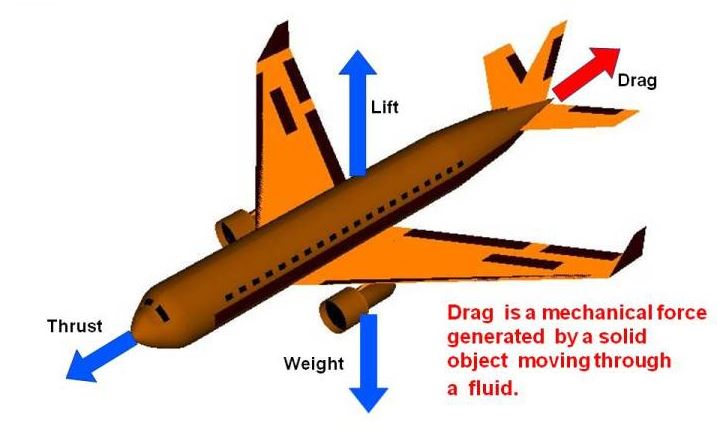Template: Difference between revisions
(→Simple) |
|||
| Line 33: | Line 33: | ||
===Simple=== | ===Simple=== | ||
You drop a single coffee filter of mass 1.1 grams from a very tall building, and it takes 46 seconds to reach the ground. In a small fraction of that time the coffee filter reached terminal speed. | |||
1. What is the upward force of air resistance while the coffee filter was falling at terminal speed? | |||
Fair= | |||
===Middling=== | ===Middling=== | ||
===Difficult=== | ===Difficult=== | ||
Revision as of 01:26, 7 December 2015
Air Resistance
In real life there are a lot factors that affect motion. When first learn physics it is much simpler to calculate the motion of an object if forces such as drag and friction are taken out of the equation because it simply makes understanding motion much easier. In this section we will be exploring the concept of air resistance in motion.
A Mathematical Model
Air resistance is a force that essentially opposes motion and dissipates energy. Much like other opposing forces, air resistance is dependent on both the speed and the size of the surface area of the object. Many things go into what affects the force of air resistance, and it can be defined by the following equation:
p = density of the air
C_D = drag coefficient (typically between .3 and 1.0)
A = cross-sectional area
v = speed of object
WHY AIR RESISTANCE DEPENDS ON THE DENSITY OF THE AIR
The density affects the air resistance for expected reasons, the denser the air is the larger the air resistance becomes. The denser the air is the more air molecules the object collides with and faster the object reaches terminal velocity. This implies that in areas with high altitudes where air is "thinner" or less dense such as Colorado there is less air resistance.
WHY AIR RESISTANCE DEPENDS ON DRAG COEFFICIENT Air resistance is affected by what is called the drag coefficient which is essentially the shape of the object. If the object has a certain shape such as a pointy edge rather than blunt edge then the air resistance is greatly reduced. For example a spherical object has a drag coefficient of .5 and irregularly shaped objects can even reach 2.
WHY AIR RESISTANCE DEPENDS ON CROSS-SECTIONAL AREA It can be seen from practice that the bigger the cross-sectional area of the object the larger the effect that air resistance has on the object. This due to the fact that air resistance is the result of the collision of an objects surface with the air molecules. This means that the bigger the surface-area the more collisions with air molecules the object will experience and the faster it'll reach terminal velocity. For example a person going sky diving will fall much slower with an open parachute (more surface area, air resistance has a bigger impact) than with a closed parachute (less surface area, air resistance has a smaller impact).
WHY AIR RESISTANCE DEPENDS ON SPEED Air resistance is affected by speed because it increases as velocity increases. This can be seen because there is always gravitational force acting on the object downward, but as the speed increases the air resistance increase making the net downward force much much smaller until it becomes 0. This means that at some point the object reaches terminal speed because there is no longer a net force acting upon it.
Examples
Be sure to show all steps in your solution and include diagrams whenever possible
Simple
You drop a single coffee filter of mass 1.1 grams from a very tall building, and it takes 46 seconds to reach the ground. In a small fraction of that time the coffee filter reached terminal speed.
1. What is the upward force of air resistance while the coffee filter was falling at terminal speed? Fair=
Middling
Difficult
Connectedness
- How is this topic connected to something that you are interested in?
This topic is connected to airplanes which are a fascinating invention. It is hard to imagine that humans have been able to find a way to get a massive object to fly into the sky. When one really delves into all the physics that getting a plane into the air requires it really is fasccinating.
- How is it connected to your major?
This is not directly connected to my major. Although the chemical engineering field is vast I do not think there is yet, a connection with the concept of drag force.
- Is there an interesting industrial application?
Air resistance is part of a much bigger application of physics known as aerodynamics which is essentially the study of how fluids and gases interact with objects in motion. The most common example of aerodynamics is airplanes. Engineers and scientist have to use the principles of aerodynamics (air resistance/drag force included) in order to determine the shape, engines, wings of a plane. It gets much more complicated when forces such a light, weight, thrust and drag come together.
See also
Are there related topics or categories in this wiki resource for the curious reader to explore? How does this topic fit into that context?
Further reading
Books, Articles or other print media on this topic
External links
Internet resources on this topic
References
Picture of the Airplane "What Is Drag?" What Is Drag? Ed. Nancy Hall. NASA, n.d. Web. 07 Dec. 2015. <https://www.grc.nasa.gov/www/k-12/airplane/drag1.html>.
HOW DOES THE DRAG COEFFICIENT AFFECT AIR RESISTANCE Nave, R. "Terminal Velocity." Hyper Physics. N.p., n.d. Web. 7 Dec. 2015. <http://hyperphysics.phy-astr.gsu.edu/hbase/airfri2.html#c3>.

